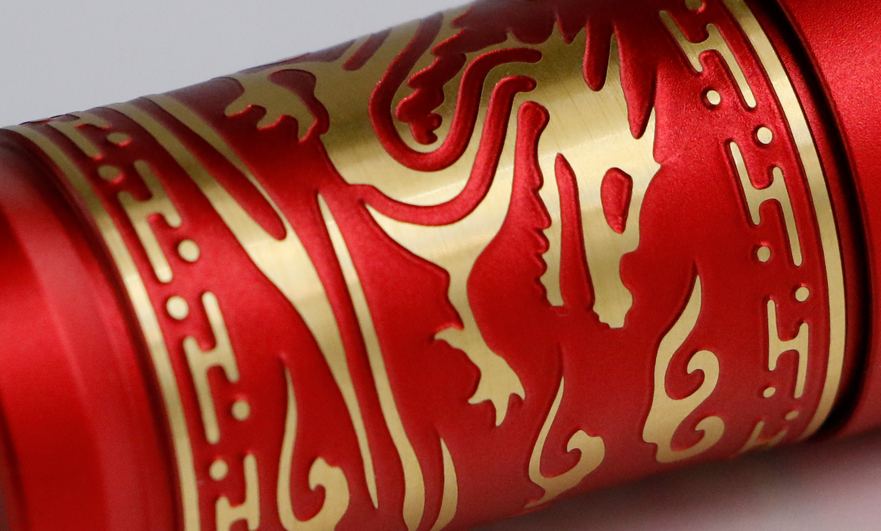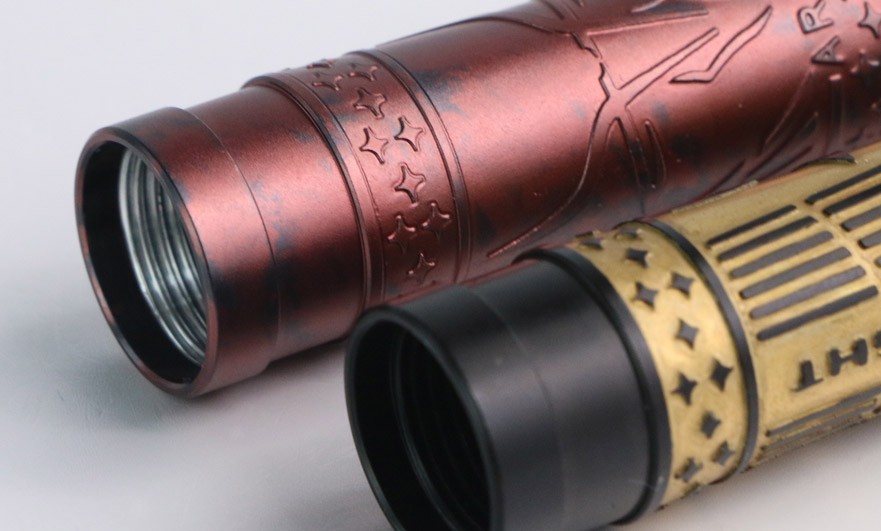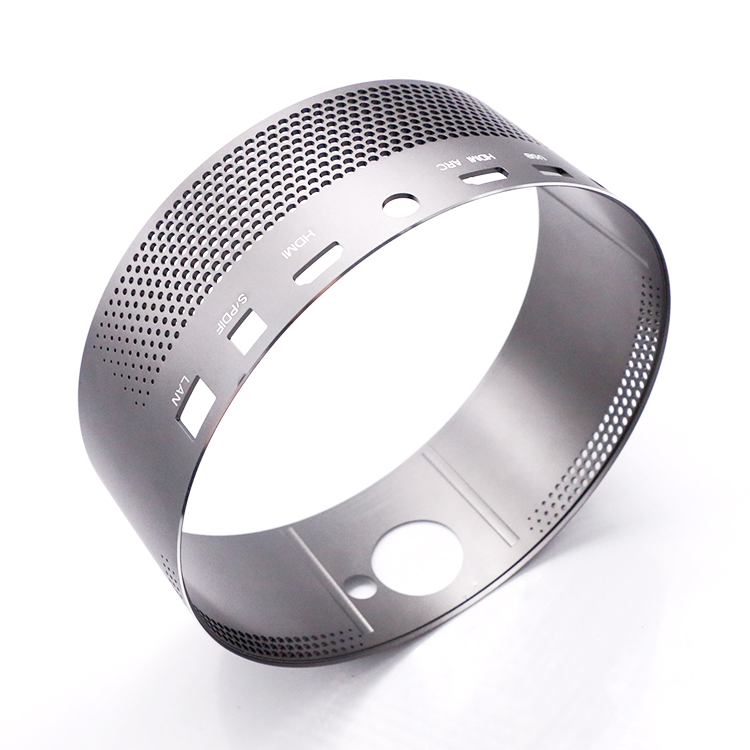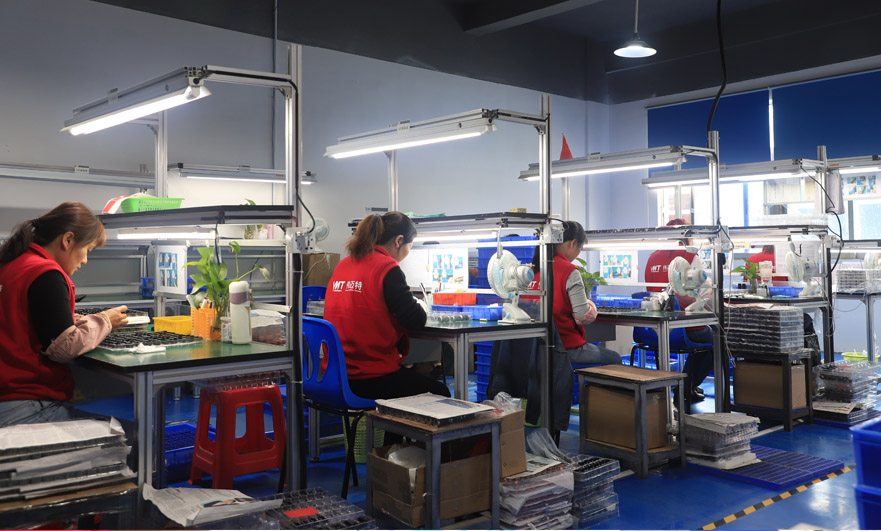15 years one-stop China custom CNC machining parts factory
 313 |
Published by VMT at Dec 23 2022
313 |
Published by VMT at Dec 23 2022
In the field of modern industrial numerical control machining, the application of lasers is becoming more and more common, and laser etching is one of them, which is currently the fastest marking process.
Laser etching anodized aluminum is one of the most common applications for laser engravers worldwide and is popular due to its unique durability and aesthetics as well as the bright, high-contrast signs produced by high-quality laser engravers.
What is etching?
Etching usually refers to photochemical etching, which refers to removing the protective film of the area to be etched after exposure and development of the plate, making the metal contact with the chemical solution during etching, and using two positive patterns to achieve the effect of dissolution and corrosion through chemical grinding from both sides. To form the effect of concave-convex or hollow molding, chemical etching is very targeted. It refers to controlled corrosion. It is a controllable machining method for metals through chemical methods. Different etchants have different corrosion characteristics and strengths for different metal materials. Etching is divided into dry etching and wet etching. Dry etching technology is further divided into reactive ion etching (RIE), sputter etching and vapor phase etching.

During laser etching, the extreme heat of the laser beam melts the metal surface after metal contact. After melting, the molten material expands, leaving marks on the surface of the material.
Laser etched designs are generated by graphic design software. This graphic design software supports vector files. Once the design is complete, it is saved as a vector file and transferred to a laser etcher for printing. Laser etchers use CNC routers to read out vector files. It also determines the pattern of laser movement and creates the desired design.
The purpose of anodizing aluminum is to convert the surface layer of aluminum to aluminum oxide. This material is more resistant to corrosion and wear than the pure aluminum that hides beneath it. Although aluminum oxide is practically transparent, some anodizing methods produce porous aluminum oxide layers that can be colored with special dyes. Therefore, anodized aluminum is more durable than regular aluminum and will not corrode, scratch or break. And it's available in many colors -- many advantages.
The anodizing process only affects the surface of the aluminum to a depth of 0.1-1.0mm. This makes the laser etching process, with an impact depth of only 0.25 mm, the best choice for marking anodized aluminum. In contrast, laser engraving has an impact depth of 3 mm, which means the laser exposes the less durable aluminum beneath the anodic layer, making the item more vulnerable to damage.
Laser etching and engraving technology is used in a wide variety of industries to mark postage stamps, monograms and barcodes. Their techniques are similar, but there are differences.
The main difference between laser etching and engraving processes is the depth of cut. Laser engraving penetrates the entire aluminum material, while laser etching is a shallow cut that only partially cuts through the material.
Laser etching is often used on anodized aluminum because it does not remove the anodized layer. This program can be used for serial numbers, barcodes or other drawings that need to be displayed but not deep.
Types of Etching Techniques
Wet etching:
Wet etching is to immerse the wafer in a suitable chemical solution, or spray the chemical solution onto the wafer for quenching, and remove the atoms on the surface of the film through the chemical reaction between the solution and the object to be etched, so as to achieve the purpose of etching. Perform wet etching During etching, the reactants in the solution first diffuse through the stagnant boundary layer, and then reach the wafer surface, where chemical reactions occur to produce various products. The products of the etch chemical reaction are liquid or gas phase products, which then diffuse through the boundary layer and dissolve into the main solution. Wet etching not only etches vertically, but also etches horizontally.

Dry etching:
Dry etching is usually a type of plasma etching or chemical etching. Due to the different etching effects, the physical atoms of the ions in the plasma, the chemical reactions of the active radicals, and the surface atoms of the device (wafer), or a combination of the two, include the following:
Physical etching: sputter etching, ion beam etching
Chemical Etching: Plasma Etching
Physicochemical Composite Etching: Reactive Ion Etching (RIE)
Dry etching is an anisotropic etching with good directionality but poorer selectivity than wet etching. In plasma etching, plasma is a partially dissociated gas in which gas molecules are dissociated into electrons, ions, and other highly chemically reactive species. The biggest advantage of dry etching is "anisotropic etching". However, (radical) dry etching is less selective than wet etching. This is because the etching mechanism of dry etching is physical interaction; therefore, the impact of ions can remove not only the etching film but also the photoresist mask.
Advantages of choosing etching machining:
The advantage of the metal etching process is that the cost of prototype machining is low, almost all metals are within the etching range, there is no limit to the hardness of the metal, no scratches, no burrs, the design is fast, simple, high efficiency, and the process takes 48 hours , The influence of material thickness on the tolerance is ±10%, product packaging, transfer is extremely convenient. The manufacturing cost of stamping is high. Although all metals can be used, metals that are too hard or too small to be easily broken cannot be used, and there are scratches on the cutting edges and local burrs.
No Change in Material Properties
The development speed is fast, the development cost is low, and it is convenient to modify the design drawing. Maintain a high degree of consistency with the raw material. It does not change the properties of the material, the stress of the material, and the hardness, tensile strength, yield strength and ductility of the material. It is etched in an atomized state in the equipment, and there is no obvious pressure on the surface. Other CNC machining methods, such as laser cutting and stamping, may alter metal properties due to thermal or mechanical stress during production;
High Precision, Low Tolerance
High precision, low tolerance. The small tolerance can be 0.005mm, the micropore diameter can be 0.03mm, the wire diameter can be 0.015mm, and the uniformity can reach +/-0.03mm
Material Quality
Laser engraving and laser etching can be used to create high-quality permanent marks on a variety of materials. However, laser engraving is generally better suited for marking hard flat surfaces, while laser etching is better suited for softer materials and curved surfaces.
Durability
Laser engraving can produce a longer lasting logo than laser etching. Laser engraving systems are often effective for parts that require high wear.
Production
High production capacity, low-cost repeatability of complex designs, rapid mass production, can be completed in a few hours or a few days; no burrs, unlike mechanical machining, the products processed by chemical corrosion are almost smooth and burr-free;

It can cooperate with the post-process stamping to complete the personalized molding action of the product, and can use the hanging point method for full-page electroplating, bonding, electrophoresis, blackening, etc., which is more cost-effective.
Etching 10 process flow:
VMT’s etching process is mainly customized for incoming drawings. It can etch various materials, with a thickness ranging from 0.03MM to 2.0MM; the minimum tolerance can be controlled at 0.0075mm, and the best engineering drawings are mainly CAD engineering drawings.
2. Preparation of raw materials
Zhuolida etching process mainly involves stainless steel (201, 202, 301, 304, 316 and 400), copper, aluminum alloy, titanium alloy, among which stainless steel (201, 202, 301, 304 , 316 and 400).
3. Cleaning process
The process before stainless steel or other metal etching is cleaning treatment, the main function is to remove dirt, dust, oil stains, etc. on the surface of the material. The cleaning process is the key to ensure good adhesion of the subsequent film or screen printing ink to the metal surface. Therefore, the oil and oxide film on the metal etching surface must be thoroughly removed. Degreasing should be determined according to the oil pollution of the workpiece. It is best to carry out electric degreasing before the screen printing ink to ensure the degreasing effect. In addition to the oxide film, the best etching solution should be selected according to the metal type and film thickness to ensure the surface is clean. Must be dry before screen printing. If there is moisture.
4. Paste dry film or silk screen photosensitive adhesive layer
According to the actual product material, thickness, and the precise width of the graphic, it is determined to use dry film or wet film silk screen printing. For products with different thicknesses, factors such as the etching machining time required for product graphics should be considered when applying the photosensitive layer. Thicker or thinner photoresist layers can be made with good coverage and high definition patterns produced by metal etching.
5. Exposure
Exposure, transfer imaging through photomask UV exposure.
This process is an important process of metal etching, and the exposure energy will be considered according to the thickness and precision of the product material. This is also a reflection of the technical capabilities of etching machining enterprises. The exposure process determines whether etching can ensure better dimensional control accuracy and other requirements.
6. Development
After exposing the photosensitive adhesive layer on the surface of the metal etching plate, the pattern adhesive layer is cured after exposure. Afterwards, the unwanted parts of the pattern, that is, the parts to be etched, are exposed. The development process also determines whether the final dimensions of the product will meet the requirements. This process will completely remove the unwanted photoresist layer from the product.
7. Drying
After the film or roller screen printing ink is finished, the photoresist layer needs to be thoroughly dried in preparation for the exposure process. At the same time, it is necessary to ensure that the surface is clean and free of adhesions and impurities.
8. Etching
After the product prefabrication process is completed, the metal is corroded by the etching solution. This process determines whether the final product is qualified or not. This process involves parameters such as the concentration, temperature, pressure, and speed of the etching solution. The quality of the product needs to be determined by these parameters.
9. Remove
The surface of the etched product is still covered with a layer of photosensitive adhesive, and the photosensitive adhesive layer on the surface of the etched product needs to be removed. Since the photosensitive adhesive layer is an acidic substance, the acid-base neutralization method is mostly used for puffing. After overflow cleaning and ultrasonic cleaning, the photosensitive adhesive layer on the surface is removed to prevent photosensitive adhesive residue.
10. Detection
After the film is taken, the follow-up is testing, packaging, and the final product confirms whether it meets its specifications. Standardized packaging, put each product into the corresponding packing box, and register the corresponding details.

Precautions in etching process
1. Reduce side corrosion and protruding edges, and improve metal etching machining coefficient: Generally, the longer the printed board is in the metal etching solution, the more serious the side etching will be. Undercut seriously affects the accuracy of printed lines, and severe undercuts will not be able to make thin lines.
The etch factor increases as undercuts and edges decrease. A high etch factor indicates the ability to maintain thin lines and bring etched lines close to the original image size. Whether the plating resist is tin-lead, tin, tin-nickel, nickel, etc., excessively protruding edges can cause shorts in the wires. Since the protruding edge breaks off easily, a bridge is formed between the two points of the wire.
2. Improve the consistency of etching machining rate between plates: in continuous plate etching, the more consistent the metal etching process rate, the more uniform etched plates can be obtained. In order to always maintain the best etching state during the pre-etching process, it is necessary to choose an etching solution that is easy to regenerate and compensate, and the etching rate is easy to control.
Choose techniques and equipment that provide constant operating conditions and enable automatic control of various solution parameters. It can be realized by controlling the amount of dissolved copper, PH value, solution concentration, temperature, uniformity of solution flow, etc.
3. Improve the uniformity of metal etching machining speed on the entire board surface: the etching uniformity of the upper and lower sides of the board and each part of the board surface is determined by the uniformity of the flow rate of the metal etching solution on the board surface.
During the etching process, the etching rates of the upper and lower plates are often inconsistent. The etch rate of the lower side is higher than that of the upper side. Due to the accumulation of solution on the surface of the upper plate, the etching reaction is weakened. The uneven etching of the upper and lower plates can be solved by adjusting the injection pressure of the upper and lower nozzles. With a spray system, oscillating nozzles, the uniformity of the entire surface of the board can be further improved by making the spray pressure different in the center and edge of the board.
Common problems and solutions in etching machining
Exposure and development problems
Etching machining is highly targeted, and metals are usually processed by chemical etching, so etching machining can also be called chemical etching machining. Common problems in chemical etching machining are as follows:
1. The rough etched surface has pitting and grooves after being etched. The main reason is that the concentration of acidic etching solution in the etching solution is too high, pickling after etching, pickling is not clean, the solution is to adjust the concentration of the components of the etching solution to meet the specified range of the process.
2. There are pits on the etched parts. This is because the concentration of the etching solution NaOH and AI3 is too high, just dilute the etching solution and reduce the concentration.
3. The edge line of the contour is very blurred. In this case, the surface of the raw material of the etched part has not been cleaned, and there are oxide films, chemical pollution, ink, etc. The solution is to establish an effective and reasonable cleaning of the raw material before entering the exposure and development. Cleaning process.
Common Uses for Laser Etching
Laser etching can produce permanent marks, and many of these methods of part marking are used on a wide range of materials, making the marking process a smart choice across industries. Due to their high demand, they are used in a wide variety of industries including aerospace, medical, automotive, military, defense, electronics, industrial and tools.
Laser etching is used in manufacturing because it creates permanent marks and physically removes material from metals at high speeds. It can mark text logos, serial numbers, 2D data and barcodes.
Often used to form projection marks before coating the material. These projection marks help maintain traceability after the material has been coated. This technology is mainly used for coating and extrusion of automotive components.
Etching machining application field
Filtration and Separation Technology
Aerospace
Precision machinery
High-end crafts
The above is the definition, type, process, advantages, process, precautions, common problems and solutions of etching. Hope it helps you. Contact us today to learn more about etching processes and complete your CNC machining project.
